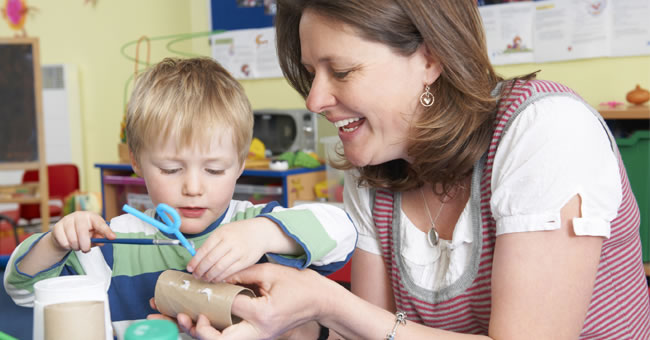
Children who are maltreated or exposed to trauma often have trouble with establishing positive relationships with others, especially adults. As children's behavioral patterns become more ingrained, establishing emotional connections with them becomes even more challenging. Over time, acts of kindness can help scale the walls of even the most wounded and distant children. In Reaching and Teaching Children Exposed to Trauma, Barbara Sorrels, EdD, provides several strategies to help early childhood educators emotionally connect with all of the preschool children in their care.
Communicating Acceptance
- Let children know that they matter by including their name in your daily greetings. Be sure to let them know that you are "looking" for them.
- Have a designated space, such as cubbies or lockers, where children can store their belongings. Label each child's storage space with the child's name and/or picture.
- Send cards to or call children who are absent for extended periods.
- Display photographs of children on the walls of the classroom.
- Display framed photos of each child's family if possible.
- Display children's work on the walls of the classroom.
- Incorporate children's interests into the curriculum.
- Celebrate students' birthdays.
The Importance of Touch
"Touch is important throughout childhood and remains one of the primary ways we connect with children. Nurturing touch communicates a sense of safety and is an important component of a healing relationship," states Sorrels. Intentional touches that send nonverbal messages of affirmation and acceptance include pats on the back, high fives, and hugs. Make sure that permission is always granted from the child and given from you before high fives or other affectionate touches are exchanged.
Games can help children who are uncomfortable with touches from their peers become more at ease. Games that involve light physical contact include parachute games, hand-clapping games, and musical hoops.
Creating Healthy Boundaries
Some children can get very easily attached. If they lack a primary attachment figure, they may be "indiscriminately attached" and approach every new person as if they are best friends. This is often the case for children who have spent some of their earliest years in an orphanage or foster care. This may also be the case for children who have been through sexual abuse. Because unwelcome touch is/has been their standard of normal, they may not understand that they need to gain permission before touching others, and they may touch them inappropriately.
If you see this behavior, tell the child to always ask permission before appropriate touching, and let them know that it is not okay to touch others in their "bathing suit areas". Explain to the child that some people are family, friends, acquaintances, and that some are strangers. Help children understand the appropriate ways of greeting the different people they encounter during the day.
Tone of Voice and Body Language
Children who have been mistreated learn to pick up on subtle verbal and nonverbal cues to tell if someone is a threat to them or not. Because of this, they often assume the worst if they perceive your expression, tone, or body language as negative. Even if you are frowning because you have a headache, some children might see your frown and think you are angry. Being aware of your tone of voice and body language can help you more effectively communicate with all children.
Eye Contact
Keeping eye contact with a child instills a sense of self-worth. If you have a child who consistently refuses to make eye contact, gently stroke your finger under the child's chin. Usually, this will get children to make eye contact for at least a moment.
Find Ways to Say Yes
"When children experience abuse and neglect as a way of life, their psychological bucket is full of nos." Here are a few ways you can fill wounded children's buckets with yeses:
- Honor a child's preference for scented playdough instead of regular playdough. Say yes to this legitimate desire.
- If you notice a child's fascination in a particular subject, bring in books or plan an activity around his/her interest.
- If you notice a child having difficulty keeping his hands quiet while listening to a story, give him/her a fidget to hold.
Invite Dependence
Maltreated children often have no one to rely on to meet their needs. This can result in an appearance of advanced maturity and an unwillingness to ask for help from adults. "Recognizing a child's need to be dependent can help adults be more understanding and patient." It's important that you're aware of how you respond when children ask for help and that you make an effort to invite dependence:
- Sometimes children who've been through trauma have a hard time paying attention, and scolding them for this will not help them learn. Be patient and allow children to be dependent on you for help.
- Show children around and teach them how things work in the classroom.
Remember that children want to be like the adults they admire. Look for similarities between you and the child, either physical or otherwise. As Barbara Barrels powerfully states in Reaching and Teaching Children Exposed to Trauma, "Sameness can break down the barriers of resistance." Be sure to browse our Social and Emotional section for a variety of resource books and materials you can use in your classroom. We also offer free resource articles to help you address challenging behaviors, understand the characteristics of traumatized children, respond to child abuse and neglect, and much more in our Insights and Inspirations section.
